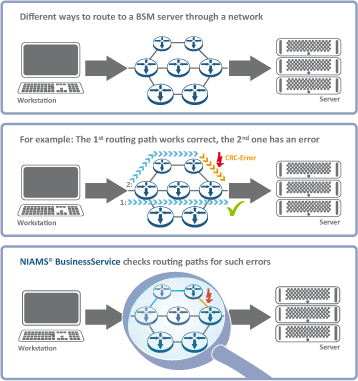Find out, why your network is slow today
No issues yesterday, but today your network is slow? Find out why.
Quite often, network administrators are facing the problem that their network yesterday worked properly obviously seems to be very slow today. Servers react very slowly, the data seems to crawl slowly through the network and it is not clear where the root cause could be.
In larger network environments it’s nearly impossible to find the reason for these kinds of performance problems quickly. In most cases it’s not a reported failure of a component, and therefore conventional monitoring solutions often do not help, because everything is available as usual.
 Typical reasons of these problems can usually be detected very quickly with NIAMS. Were there any configuration changes? Routing changes? Increased error rates on interfaces? NIAMS shows relevant differences in the current snapshot at an earlier very clearly.
Typical reasons of these problems can usually be detected very quickly with NIAMS. Were there any configuration changes? Routing changes? Increased error rates on interfaces? NIAMS shows relevant differences in the current snapshot at an earlier very clearly.
Increased utilization or error rates on interfaces, increased packet drops or path changes may indicate the reasons why certain applications only react very slowly or only low transfer rates can be achieved. A possible reason is a WAN link mal functionn? A Path-Change would in this case force the change to a backup line with lower bandwidth. Were there any changes to the configuration of the network components? Or even new components may come which will be responsible for a change in routing?
NIAMS helps find these kind of changes in your network with a few mouse clicks. You can inspect issues in your network listed by categories (like loops, high or critical interface utilization, splitted paths...) or in our easy to handle 3D Topology View.
Due to the availability of historical data, it is also possible to subsequently investigate causes a temporary disruption. NIAMS also collects older snapshots of your network via a configurable period of time, and lets you longer to recognize past changes and understand the implications. Any snapshot can serve here as a reference to any other, so for example, are also visible changes that have taken place over a period of several months.

